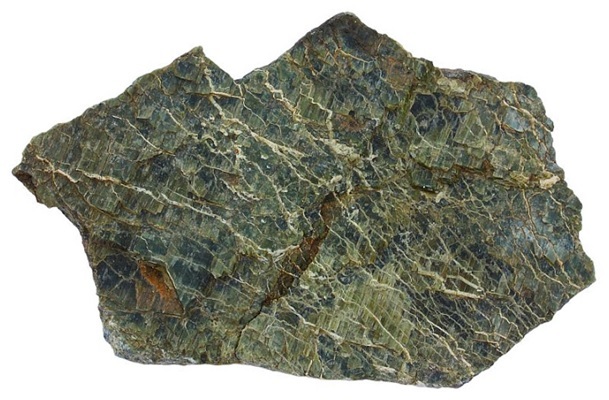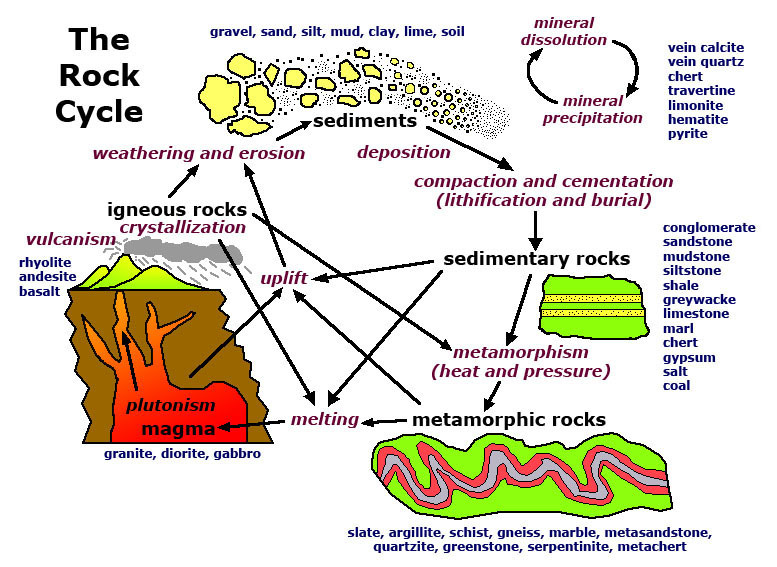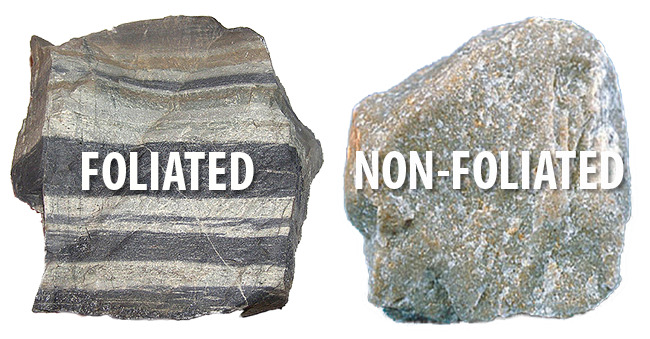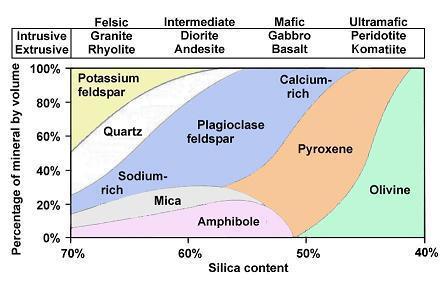
Photo: Example
**This cache is located within an area frequently patrolled by Police. Please avoid acting suspiciously whilst searching for it, and if challenged, explain about geocaching. It may be worth pointing out that it is not a physical box you are looking for, but are simply studying the rocks visible to everyone.**
The learning point of this earthcache is to get the geocacher to become familiar with the Metamorphic rock Serpentinite.
Metamorphic Rocks
Exposure to intense heat, pressure and chemical processes can result in the metamorphism of previously formed rocks, this is the way a metamorphic rock forms.

The word metamorphism comes from the word, morph which means transformed or changed. We can say that the metamorphic rocks are the “unlucky” rocks of the world because they got to their current state after being tortured by intense heat and pressure. So, metamorphic rocks are previously formed rocks that have been transformed by exposure to heat and/or pressure. This is the two influencing factors that can transform pre-existing rocks into metamorphic rocks. And as you can image, it takes very intense heat and pressure to make a rock change its form. In fact, the heat needed to make this change often comes from magma, which is the extremely hot fluid that forms below the surface of the Earth that is associated with volcanoes.
The pressure involved in metamorphism may come from the rock being deeply buried and this creates such intense pressure that crystals within the rock can grow together or collapse and rearrange into new mineral crystals. We also see that metamorphic rocks may be influenced by a third factor: the chemically active fluids that circulate around the newly forming rock and introduce different ions, which cause new and different mineral crystals to grow.
Every metamorphic rock has a parent rock! These parent rocks can be any type of rocks like igneous, sedimentary or even other metamorphic rocks. Knowing the parent rock can helps us classify these rocks, and we can further classify them by their texture.
Recrystallization, Neometamorphism, and Metasomatism
There are different metamorphic processes that are responsible for the changes that we see in these rocks. Recrystallization is most common and is defined as the metamorphic process by which crystals are packed together creating a new crystal structure. Recrystallization requires a lot of heat and pressure, and the process changes the mineral's size and shape, but the basic composition remains unchanged.
There are many examples of this like: limestone can go through the process of recrystallization to turn into marble. Limestone contains tiny calcite crystals that come from shells of marine creatures that were broken down and compacted into the sedimentary rock. When metamorphosed, those tiny crystals are slowly forced together under high pressure and begin to form larger, more visible crystals of calcite found in the metamorphic rock marble.
In other situations, mineral crystals may completely rearrange to form completely new minerals that are more stable under increased pressure and/or temperatures. This process is known as neometamorphism. This is most often observed with the sedimentary rock shale, which is composed of fine grained quartz, feldspars, and other clay minerals. When metamorphosed, these minerals grains will change to muscovite mica and garnet.
The process of metasomatism results in the loss or addition of chemicals. This can best be seen in the production of anthracite coal, which is almost pure carbon. The parent rock bituminous coal is produced from the aggregation of dead plant material, and anthracite is produced by the loss of the more volatile materials such as nitrogen, oxygen, and methane.

There are two basic types of metamorphic rocks.
Foliated metamorphic rocks such as gneiss, phyllite, schist, and slate have a layered or banded appearance that is produced by exposure to heat and directed pressure.
Non-foliated metamorphic rocks such as hornfels, marble, quartzite, and novaculite do not have a layered or banded appearance.
Serpentinite
Serpentinite is a metamorphic rock that is mostly composed of serpentine group minerals. Serpentine group minerals antigorite, lizardite, and chrysotile are produced by the aqueous change of *ultramafic rocks. These are igneous rocks that are composed of olivine and pyroxene (peridotite, pyroxenite). Serpentine group minerals occur less commonly in some olivine-bearing marbles (ophicalcite) and kimberlites, but these rocks are normally not considered to be serpentinites.
Serpentinites form as a result of serpentinization. These are chemical reactions which convert anhydrous ferromagnesian silicate minerals (pyroxene, olivine) into hydrous silicate minerals (serpentine) plus some other possibilities like brucite and magnetite. Brucite forms if the precursor rocks are rich in magnesium (dunite, for example). Magnetite forms if there is enough iron present (pyroxenite). Usually serpentinite contains iron in the form of magnetite which gives dark color to serpentinites.
Serpentinite is probably very widespread rock deep below, but not nearly as common in the upper parts of the crust. Here it occurs mostly where ultramafic rocks occur (**ophiolite complexes). Serpentine minerals along with other green, green-ish-colored alteration minerals (talc and chlorite) are still pretty widely distributed because olivine and pyroxenes are readily available in many places. Serpentinites has been important sources of asbestos, but nowadays the use of asbestos has diminished considerably because of health concerns.
* Ultramafic rocks are igneous and meta-igneous rocks with a very low silica content. The earth`s mantle is composed of ultramafic rocks. See also diagram under.
** An ophiolite is a section of the Earth's oceanic crust and the underlying upper mantle that has been uplifted and exposed above sea level and often emplaced onto continental crust rocks.

To log this cache.
To get to log this cache you will have to visit and answer the questions which are related to the coordinates given the earthcache.
When answers are collected, send them to CO for verification.
You can log immediately after answers are sent CO. If there are any questions about your answers CO will contact you.
Logs without answers to CO or with pending questions from CO will be deleted without any further notice.
Please do not include pictures in your log that may answer the questions.
Questions:
1. Answer the questions under by visiting the Coordinates.
A. Go to the coordinates and study the Serpentinite closely. Describe the surface and texture of the stone?
B. Magnetite forms if there is enough iron present, study the stone, do you find this here in the stone? Describe!
C.Which of the given option: A, B, C, or D from the photo below is similar to the Serpentinite that we find here at ground zero?

2. (It’s voluntary to post a photo in your online log of your visit)
